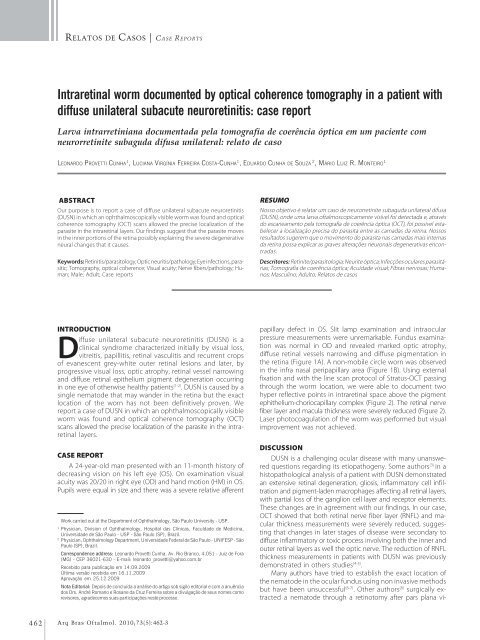Monovision and cataract surgery Visual field and OCT correlation ...
Monovision and cataract surgery Visual field and OCT correlation ...
Monovision and cataract surgery Visual field and OCT correlation ...
You also want an ePaper? Increase the reach of your titles
YUMPU automatically turns print PDFs into web optimized ePapers that Google loves.
RELATOS DE CASOS | CASE REPORTS<br />
Intraretinal worm documented by optical coherence tomography in a patient with<br />
diffuse unilateral subacute neuroretinitis: case report<br />
Larva intrarretiniana documentada pela tomografia de coerência óptica em um paciente com<br />
neurorretinite subaguda difusa unilateral: relato de caso<br />
LEONARDO PROVETTI CUNHA 1 , LUCIANA VIRGÍNIA FERREIRA COSTA-CUNHA 1 , EDUARDO CUNHA DE SOUZA 2 , MÁRIO LUIZ R. MONTEIRO 1<br />
ABSTRACT<br />
Our purpose is to report a case of diffuse unilateral subacute neuroretinitis<br />
(DUSN) in which an ophthalmoscopically visible worm was found <strong>and</strong> optical<br />
coherence tomography (<strong>OCT</strong>) scans allowed the precise localization of the<br />
parasite in the intraretinal layers. Our findings suggest that the parasite moves<br />
in the inner portions of the retina possibly explaining the severe degenerative<br />
neural changes that it causes.<br />
Keywords: Retinitis/parasitology; Optic neuritis/pathology; Eye infections, parasitic;<br />
Tomography, optical coherence; <strong>Visual</strong> acuity; Nerve fibers/pathology; Human;<br />
Male; Adult; Case reports<br />
RESUMO<br />
Nosso objetivo é relatar um caso de neurorretinite subaguda unilateral difusa<br />
(DUSN), onde uma larva oftalmoscopicamente visível foi detectada e, através<br />
do escaneamento pela tomografia de coerência óptica (<strong>OCT</strong>), foi possível estabelecer<br />
a localização precisa do parasita entre as camadas da retina. Nossos<br />
resultados sugerem que o movimento do parasita nas camadas mais internas<br />
da retina possa explicar as graves alterações neuronais degenerativas encontradas.<br />
Descritores: Retinite/parasitologia; Neurite óptica; Infecções oculares parasitárias;<br />
Tomografia de coerência óptica; Acuidade visual; Fibras nervosas; Humanos;<br />
Masculino; Adulto; Relatos de casos<br />
INTRODUCTION<br />
Diffuse unilateral subacute neuroretinitis (DUSN) is a<br />
clinical syndrome characterized initially by visual loss,<br />
vitreitis, papillitis, retinal vasculitis <strong>and</strong> recurrent crops<br />
of evanescent grey-white outer retinal lesions <strong>and</strong> later, by<br />
progressive visual loss, optic atrophy, retinal vessel narrowing<br />
<strong>and</strong> diffuse retinal epithelium pigment degeneration occurring<br />
in one eye of otherwise healthy patients (1-2) . DUSN is caused by a<br />
single nematode that may w<strong>and</strong>er in the retina but the exact<br />
location of the worn has not been definitively proven. We<br />
report a case of DUSN in which an ophthalmoscopically visible<br />
worm was found <strong>and</strong> optical coherence tomography (<strong>OCT</strong>)<br />
scans allowed the precise localization of the parasite in the intraretinal<br />
layers.<br />
CASE REPORT<br />
A 24-year-old man presented with an 11-month history of<br />
decreasing vision on his left eye (OS). On examination visual<br />
acuity was 20/20 in right eye (OD) <strong>and</strong> h<strong>and</strong> motion (HM) in OS.<br />
Pupils were equal in size <strong>and</strong> there was a severe relative afferent<br />
Work carried out at the Department of Ophthalmology, São Paulo University - USP.<br />
1<br />
Physician, Division of Ophthalmology, Hospital das Clínicas, Faculdade de Medicina,<br />
Universidade de São Paulo - USP - São Paulo (SP), Brazil.<br />
2<br />
Physician, Ophthalmology Department, Universidade Federal de São Paulo - UNIFESP - São<br />
Paulo (SP), Brazil.<br />
Correspondence address: Leonardo Provetti Cunha. Av. Rio Branco, 4.051 - Juiz de Fora<br />
(MG) - CEP 36021-630 - E-mail: leonardo_provetti@yahoo.com.br<br />
Recebido para publicação em 14.09.2009<br />
Última versão recebida em 16.11.2009<br />
Aprovação em 25.12.2009<br />
Nota Editorial: Depois de concluída a análise do artigo sob sigilo editorial e com a anuência<br />
dos Drs. André Romano e Rosane da Cruz Ferreira sobre a divulgação de seus nomes como<br />
revisores, agradecemos suas participações neste processo.<br />
papillary defect in OS. Slit lamp examination <strong>and</strong> intraocular<br />
pressure measurements were unremarkable. Fundus examination<br />
was normal in OD <strong>and</strong> revealed marked optic atrophy,<br />
diffuse retinal vessels narrowing <strong>and</strong> diffuse pigmentation in<br />
the retina (Figure 1A). A non-mobile circle worn was observed<br />
in the infra nasal peripapillary area (Figure 1B). Using external<br />
fixation <strong>and</strong> with the line scan protocol of Stratus-<strong>OCT</strong> passing<br />
through the worm location, we were able to document two<br />
hyper reflective points in intraretinal space above the pigment<br />
ephithelium-choriocapillary complex (Figure 2). The retinal nerve<br />
fiber layer <strong>and</strong> macula thickness were severely reduced (Figure 2).<br />
Laser photocoagulation of the worm was performed but visual<br />
improvement was not achieved.<br />
DISCUSSION<br />
DUSN is a challenging ocular disease with many unanswered<br />
questions regarding its etiopathogeny. Some authors (3) in a<br />
histopathological analysis of a patient with DUSN demonstrated<br />
an extensive retinal degeneration, gliosis, inflammatory cell infiltration<br />
<strong>and</strong> pigment-laden macrophages affecting all retinal layers,<br />
with partial loss of the ganglion cell layer <strong>and</strong> receptor elements.<br />
These changes are in agreement with our findings. In our case,<br />
<strong>OCT</strong> showed that both retinal nerve fiber layer (RNFL) <strong>and</strong> macular<br />
thickness measurements were severely reduced, suggesting<br />
that changes in later stages of disease were secondary to<br />
diffuse inflammatory or toxic process involving both the inner <strong>and</strong><br />
outer retinal layers as well the optic nerve. The reduction of RNFL<br />
thickness measurements in patients with DUSN was previously<br />
demonstrated in others studies (4-5) .<br />
Many authors have tried to establish the exact location of<br />
the nematode in the ocular fundus using non invasive methods<br />
but have been unsuccessful (6-7) . Other authors (8) surgically extracted<br />
a nematode through a retinotomy after pars plana vi-<br />
462<br />
Arq Bras Oftalmol. 2010;73(5):462-3

















